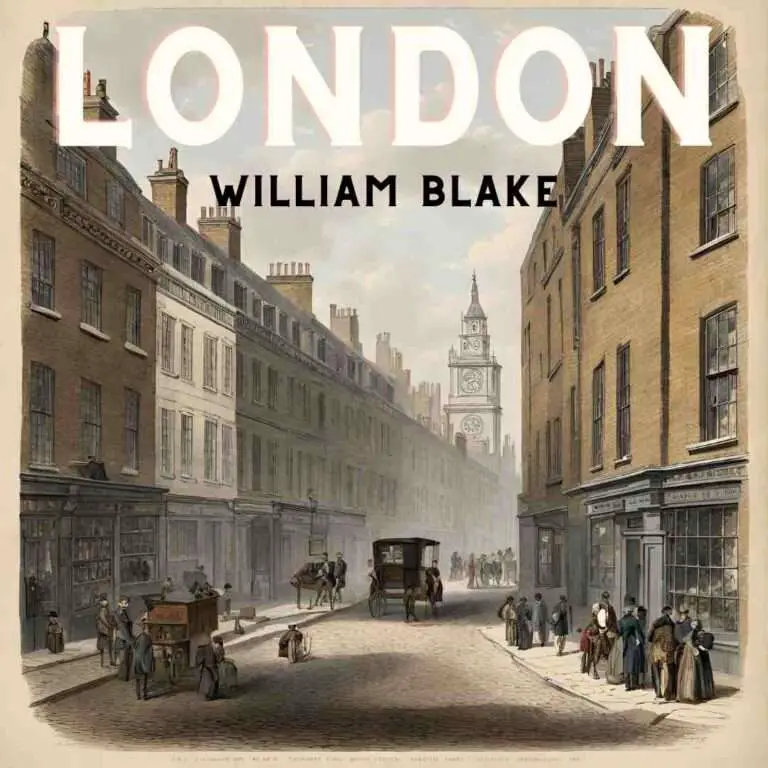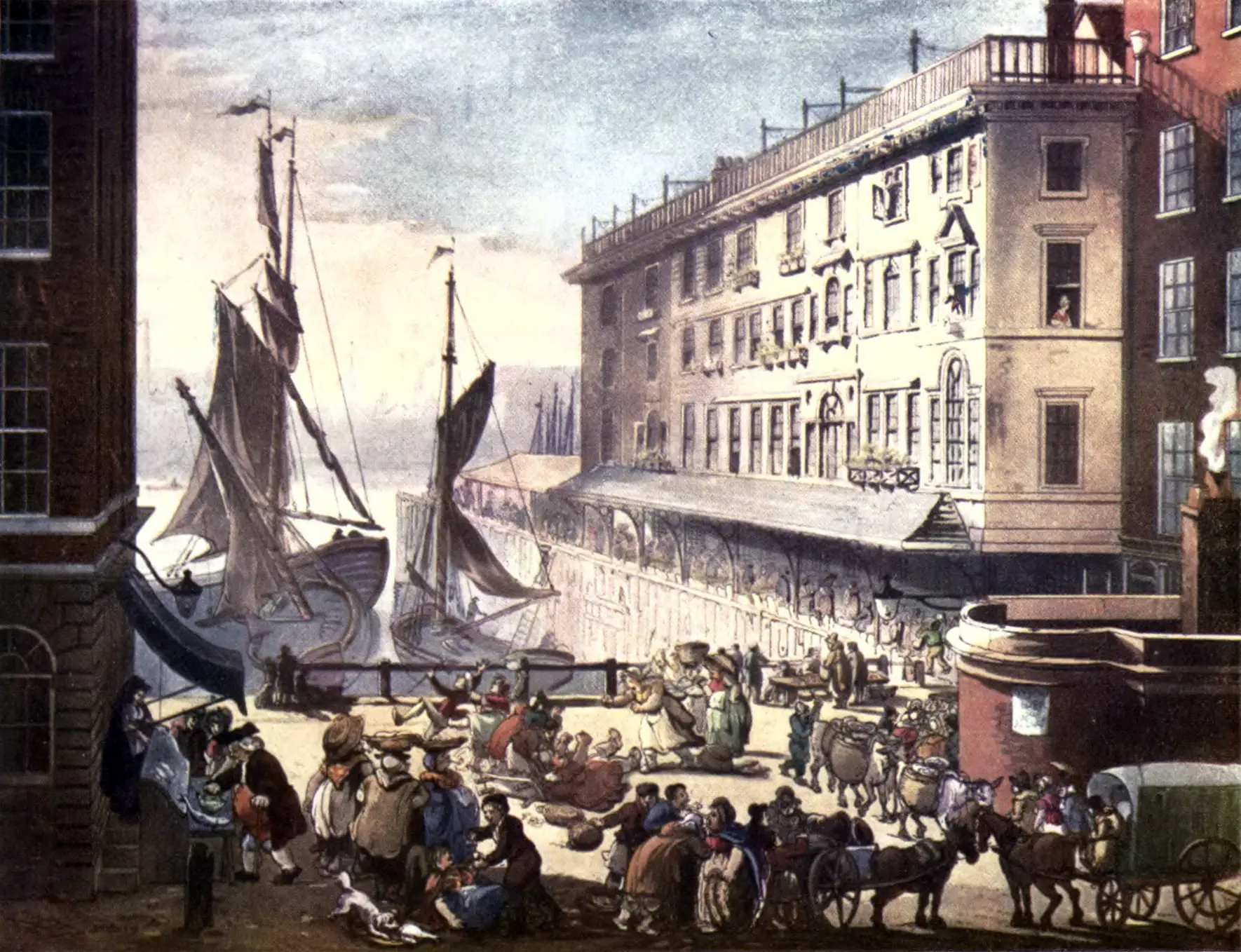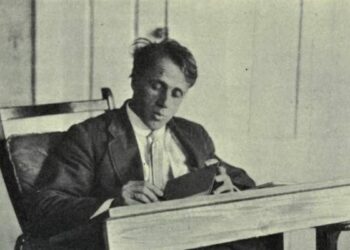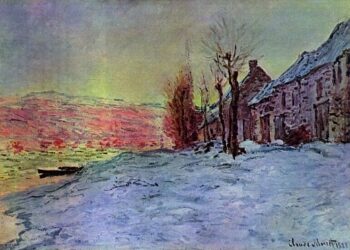Introduction to the Poem
London Summary Linewise By William Blake “London,” written by William Blake in 1794 as part of his collection Songs of Experience, is a powerful critique of the social and political conditions in London during the late 18th century. Through vivid imagery and stark contrasts, Blake exposes the suffering, oppression, and moral decay he observes in the city.London Summary Linewise By William Blake
Line-by-Line Summary
Lines 1-2: “I wander thro’ each chartered street, / Near where the chartered Thames does flow.”
London Summary Linewise By William Blake The poem begins with the speaker wandering through the streets of London, which are described as “chartered.” This word suggests that the streets are regulated and owned, highlighting a sense of control and restriction. The reference to the “chartered Thames” emphasizes that even the river is constrained, reflecting the broader theme of entrapment within the city’s framework.London Summary Linewise By William Blake
Read More
Lines 3-4: “And mark in every face I meet / Marks of weakness, marks of woe.”
As the speaker observes the faces of the people he encounters, he notes signs of suffering and despair. The repetition of the word “marks” suggests that these afflictions are visible and pervasive, indicating that emotional and physical weakness is a common experience among Londoners.
Lines 5-6: “In every cry of every Man, / In every Infant’s cry of fear.”
The speaker hears the cries of men and infants, linking their suffering to the oppressive environment. The cry of the infant, in particular, symbolizes innocence threatened by the harsh realities of life in London. This evokes a sense of helplessness and vulnerability in the face of societal neglect.London Summary Linewise By William Blake
Lines 7-8: “In every voice: in every ban, / The mind-forg’d manacles I hear.”
Blake introduces the idea of “mind-forg’d manacles,” a powerful metaphor for the psychological chains that bind individuals in society. The phrase suggests that the suffering is not only physical but also mental, with societal constraints limiting personal freedom and agency. The “ban” refers to restrictions imposed by authority, further emphasizing the theme of oppression.London Summary Linewise By William Blake

Lines 9-10: “How the Chimney-sweeper’s cry / Every black’ning Church appalls.”
The cries of chimney sweepers—often children forced into labor—are juxtaposed against the “black’ning Church.” Here, Blake critiques the Church’s failure to protect the vulnerable and highlights its complicity in societal ills. The image of the church blackening suggests moral corruption, contrasting its intended role as a sanctuary.
Read More
Lines 11-12: “And the hapless Soldier’s sigh / Runs in blood down Palace walls.”
This line connects the suffering of soldiers, likely referring to the impact of war and conflict, to the imagery of blood on the Palace walls. This stark imagery illustrates the violent consequences of societal neglect and the burden of war, implicating the ruling elite in the suffering of the common people.London Summary Linewise By William Blake
Lines 13-14: “But most thro’ midnight streets I hear / How the youthful Harlot’s curse.”
The speaker hears the “youthful Harlot’s curse” echoing through the streets at night, representing the plight of women forced into prostitution. This line emphasizes the degradation of youth and the moral decay of society, showcasing the darker side of urban life and the exploitation of vulnerable individuals.London Summary Linewise By William Blake

Lines 15-16: “Blasts the new-born Infants tear, / And blights with plagues the Marriage hearse.”
The final lines present a chilling contrast: the “new-born Infants’ tear” signifies innocence tainted by the harsh realities of life, while the phrase “Marriage hearse” suggests that even the institution of marriage, often seen as a symbol of love and stability, is corrupted and ultimately leads to death and despair. This powerful imagery encapsulates the poem’s overarching themes of loss, suffering, and the pervasive sense of hopelessness in Blake’s London.London Summary Linewise By William Blake
Read More
Conclusion
In “London,” Blake employs stark imagery, repetition, and metaphor to convey his deep concern for the moral and social decay of the city. His observations reflect a broader critique of the societal structures that perpetuate suffering and oppression, making the poem a timeless reflection on human condition and urban life.London Summary Linewise By William Blake
FAQ
1. What is the main theme of the poem “London”?
The main theme of “London” is the critique of social injustice and the suffering experienced by its inhabitants. Blake explores the effects of industrialization, poverty, and moral decay, portraying a city rife with oppression and despair.
2. What does Blake mean by “mind-forg’d manacles”?
“Mind-forg’d manacles” refers to the psychological constraints and limitations imposed on individuals by society. It suggests that people’s thoughts and beliefs, shaped by societal norms and expectations, can confine them just as physically binding chains would.
3. How does Blake use imagery in the poem?
Blake uses vivid and stark imagery throughout the poem to illustrate the suffering and despair of London’s inhabitants. For example, the imagery of the “Chimney-sweeper’s cry” and “blood down Palace walls” evokes strong emotional responses and highlights the stark contrasts between the privileged and the oppressed.
4. What role does the Church play in the poem?
The Church is depicted as complicit in the suffering of the people. Blake critiques its failure to protect the vulnerable, exemplified by the “black’ning Church” that contrasts with its moral responsibilities. This portrayal reflects Blake’s disillusionment with organized religion during his time.
5. How does the poem reflect the historical context of Blake’s time?
“London” reflects the social and political climate of late 18th-century England, marked by rapid industrialization, poverty, and class disparity. Blake’s observations highlight the consequences of these changes on human lives, particularly those of the marginalized and oppressed.
6. What is the significance of the phrase “Marriage hearse”?
The phrase “Marriage hearse” signifies the corruption of marriage as an institution, suggesting that love and commitment are overshadowed by death and despair. It reflects Blake’s belief that societal values have decayed, leading to the destruction of familial and social bonds.
7. How does “London” compare to Blake’s earlier work, “Songs of Innocence”?
“London” serves as a counterpoint to Blake’s earlier collection, Songs of Innocence, which presents a more optimistic view of the world. In contrast, Songs of Experience depicts the harsh realities of life, illustrating the loss of innocence and the pervasive suffering in society.
8. What literary devices are prominent in “London”?
Blake employs several literary devices, including imagery, metaphor, repetition, and alliteration. These devices enhance the emotional impact of the poem and help convey its themes of suffering and oppression.
9. What can modern readers learn from “London”?
Modern readers can draw parallels between the societal issues Blake addressed and contemporary challenges, such as inequality, urban decay, and the plight of marginalized communities. The poem serves as a reminder of the importance of social justice and the need to address the root causes of suffering.
10. Why is “London” considered a significant work in English literature?
“London” is considered significant for its poignant critique of society and its exploration of complex themes related to human suffering and moral decay. Blake’s innovative use of language and imagery, combined with his deep philosophical insights, solidifies the poem’s place as a powerful commentary on the human condition.
Read More

















